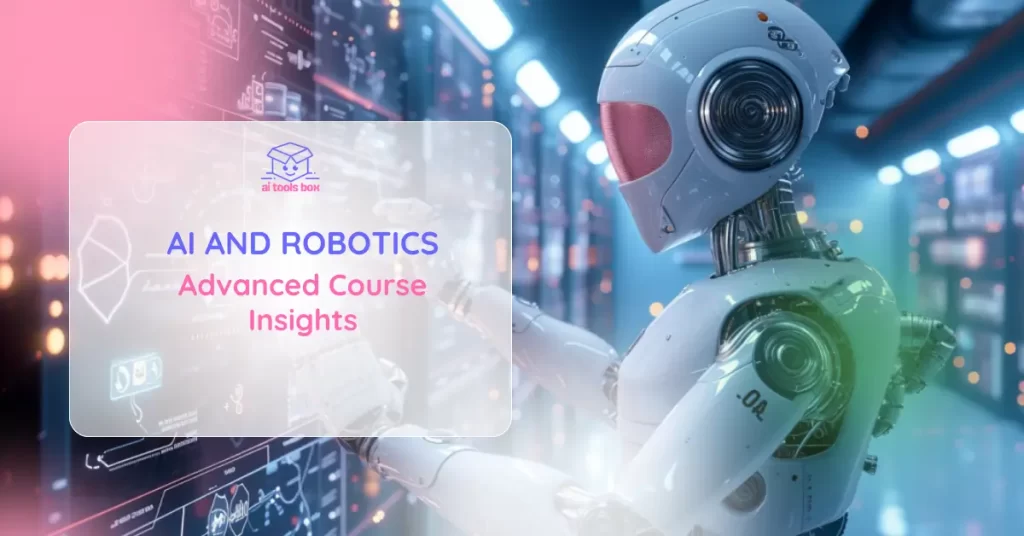AI and robotics have emerged as two interrelated fields that have revolutionized various industries, including manufacturing, healthcare, and transportation. This advanced course delves deeper into the integration of AI and robotics, exploring cutting-edge research and applications that are shaping the future of these fields.
Definition and scope
AI focuses on developing machines that can simulate human intelligence, whereas robotics deals with the design and production of robots capable of interacting with the physical world. The integration of AI and robotics involves creating intelligent machines that can understand, reason, learn, and make decisions in real-world environments.
Interconnection between AI and robotics
AI provides the cognitive capabilities for robots, enabling them to perceive, comprehend, and reason about their surroundings. Robotics, on the other hand, provides the physical embodiment for AI, allowing machines to interact with their environment through sensors and actuators.
Importance of studying AI and robotics
Studying AI and robotics is crucial in understanding the technological advancements shaping our world. By exploring these fields at an advanced level, students can gain insights into the challenges, opportunities, and ethical considerations associated with AI and robotics. This knowledge prepares students to contribute to the development and application of AI and robotics technologies across industries.
Key Concepts in AI and Robotics
To fully grasp the integration of AI and robotics, it is essential to understand key concepts in both fields. The following concepts form the foundation of AI and robotics:
Machine learning algorithms
Machine learning algorithms enable robots to learn from data and improve their performance over time. Students will explore algorithms such as supervised learning, unsupervised learning, and reinforcement learning, understanding how they can be applied to various robotics tasks.
Computer vision and perception
Computer vision allows robots to interpret and understand visual input from cameras and sensors. Students will delve into techniques such as object recognition, pose estimation, and scene understanding, which enable robots to perceive and interact with their environment effectively.
Motion planning and control
Motion planning and control algorithms enable robots to navigate and manipulate objects in their surroundings. Students will learn about path planning algorithms, kinematics, and dynamics, which are essential for robots to move efficiently and carry out tasks accurately.
Human-robot interaction
Understanding how humans and robots can interact seamlessly is crucial for the integration of AI and robotics. Students will explore areas such as natural language processing, gesture recognition, and social robotics, studying how robots can understand and respond to human commands and gestures.
Integration of AI and Robotics
The integration of AI and robotics has led to numerous advancements in various industries. In this section, we will explore some key applications where AI and robotics are making a significant impact:
Autonomous vehicles
Autonomous vehicles rely on AI and robotics technologies to navigate and make decisions in real-time. Students will delve into perception systems, control algorithms, and decision-making processes that enable self-driving cars to operate safely and efficiently on the roads.
Industrial automation
AI and robotics have transformed industrial processes through automation. Students will explore robotic arms, machine vision systems, and AI algorithms that enable robots to perform tasks such as assembly, welding, and material handling in manufacturing environments.
Healthcare robotics
Robots are being used in healthcare settings to assist with tasks such as patient monitoring, medication delivery, and rehabilitation. Students will study how AI and robotics enable these robots to understand patient needs, navigate hospitals, and interact safely with humans.
Service and companion robots
Service and companion robots are designed to assist humans in various settings, such as homes and public spaces. Students will explore how AI and robotics technologies make these robots capable of performing tasks such as cleaning, companionship, and customer service.
Challenges and Ethical Considerations
While AI and robotics offer numerous benefits, they also pose significant challenges and ethical considerations. Students in this advanced course will delve into the following topics:
Safety and reliability
Ensuring the safety and reliability of AI-powered robots is a critical concern. Students will explore topics like fault tolerance, fail-safe mechanisms, and risk assessment to understand how to design robots that are safe to operate in various environments.
Implications on employment
The integration of AI and robotics has the potential to impact the workforce significantly. Students will examine the social and economic implications of automation, studying strategies to address job displacement and promote responsible deployment of AI and robotics technologies.
Privacy and security
AI and robotics involve the collection and processing of vast amounts of data, raising concerns about privacy and security. Students will explore methods to protect sensitive information, prevent data breaches, and develop ethical data collection practices.
Ethical use of AI in robotics
The advanced course will also delve into the ethical considerations surrounding the use of AI in robotics. Topics such as bias in AI algorithms, transparency of decision-making processes, and accountability of autonomous systems will be discussed to foster responsible and ethical AI practices.
Cutting-edge Research and Innovation
Advancements in AI and robotics research continue to push the boundaries of what machines can achieve. In this section, students will explore some of the latest research areas and innovations in the field:
Reinforcement learning for robotics
Reinforcement learning techniques are being applied to robotics to enable robots to learn and improve their behavior through trial and error. Students will study state-of-the-art algorithms and explore their applications in robotics tasks such as manipulation and locomotion.
Swarm robotics
Swarm robotics involves the coordination of large groups of robots to perform tasks collectively. Students will examine the principles behind swarm intelligence and explore how it can be applied to areas such as search and rescue missions, exploration, and environmental monitoring.
Soft robotics
Soft robotics focuses on creating robots with flexible and compliant bodies, mimicking the capabilities of living organisms. Students will explore novel materials and designs that enable soft robots to navigate complex environments, interact safely with humans, and manipulate objects with dexterity.
Explainable AI in robotics
As AI algorithms become more complex, it becomes crucial to understand and interpret their decision-making processes. Students will delve into explainable AI techniques, exploring how they can be applied in robotics to make the decision-making of intelligent systems more transparent and understandable.
Applications and Real-world Examples
To solidify their understanding of AI and robotics, students will explore real-world applications and use cases across various industries:
Robotic surgery
Robot-assisted surgery has become increasingly prevalent in the medical field. Students will study how robotic systems are used in surgical procedures, enabling surgeons to perform minimally invasive, precise, and safe operations.
Warehouse automation
AI and robotics technologies have transformed the logistics industry with automated warehouse systems. Students will explore how robots navigate, pick, and pack items in warehouses, improving efficiency and reducing human labor.Assistive robotics
Robots are being used to assist individuals with disabilities or special needs in their daily lives. Students will examine how AI and robotics technologies enable assistive robots to aid in tasks such as mobility support, personal care, and rehabilitation.
Search and rescue missions
AI and robotics play a crucial role in search and rescue operations during natural disasters or accidents. Students will learn about the deployment of robots equipped with sensors and cameras to locate and rescue survivors in hazardous environments.
Future of AI and Robotics
AI and robotics continue to evolve rapidly, with exciting advancements on the horizon. In this section, students will explore the future possibilities and trends in these fields:
Advancements in perception and cognition
Researchers are continually pushing the boundaries of perception and cognition in robots. Students will discuss emerging technologies such as advanced sensors, deep learning algorithms, and neuromorphic computing, which enhance robots' ability to understand and interact with the world.
Human augmentation
The integration of AI and robotics with the human body opens up possibilities for human augmentation. Students will explore advancements in exoskeletons, prosthetics, and brain-computer interfaces, which enhance human capabilities and enable individuals with disabilities to regain mobility and functionality.
Ethical implications and regulation
As AI and robotics become more prominent in society, ethical considerations and regulations become paramount. Students will examine ethical frameworks, such as the responsible AI principles, and discuss the importance of ensuring that AI and robotics technologies are developed and used for the benefit of humanity.
Collaborative AI-robot systems
The future will witness increased collaboration between AI systems and robots. Students will explore how AI systems can work in tandem with robots to perform complex tasks, leveraging the strengths of both technologies. Topics such as human-AI teaming and explainable AI will be discussed.
Conclusions
In this advanced course on AI and Robotics, students dive deep into the integration of these two fields. They explore key concepts and technologies such as machine learning algorithms, computer vision, motion planning, and human-robot interaction. The course covers various real-world applications, including autonomous vehicles, industrial automation, healthcare robotics, and service robots. Students also delve into challenges and ethical considerations related to safety, employment, privacy, and ethical use of AI in robotics. The course highlights cutting-edge research areas, such as reinforcement learning, swarm robotics, soft robotics, and explainable AI. Real-world examples, including robotic surgery, warehouse automation, assistive robotics, and search and rescue missions, provide practical insights. Lastly, the course concludes with a glimpse into the future of AI and robotics, focusing on advancements in perception, human augmentation, ethical implications, and collaborative AI-robot systems.



